
Configurable Forms, Service Tracking & Dashboards: What Great Child Welfare Software Offers
The caseworker sighs. Another intake. Another stack of paper. Another late-night data entry session because half the forms don’t match the current program requirements. Somewhere in that shuffle? The details of a child’s story—details that matter more than the paperwork itself.
It doesn’t have to be this way.
The best child welfare software doesn’t just digitize paperwork. It transforms how caseworkers capture, track, and share information—making it easier to focus on what actually matters: protecting kids and supporting families.
Here’s what great child welfare tools bring to the table.
Table of Contents
ToggleConfigurable Forms That Fit Reality, Not the Other Way Around
Child welfare work is complicated. No two families look alike. No two programs require the same data. So why should every caseworker be stuck with cookie-cutter forms?
Modern child welfare platforms let you:
- Customize intake fields by program or region.
- Add or remove assessment questions without IT bottlenecks.
- Capture data specific to cultural, community, or state requirements.
Instead of bending services to fit the software, the software bends to fit the services. Flexible forms mean caseworkers aren’t forced into awkward workarounds—and kids don’t fall through the cracks because a form couldn’t capture the full story.
Service Tracking That Goes Beyond Checkboxes
Tracking services isn’t just about marking tasks complete. It’s about seeing whether the right supports are delivered at the right time.
Great child welfare software provides:
- A complete timeline of services—housing, counseling, health visits, education referrals.
- Alerts when critical steps are overdue.
- Cross-program visibility so multiple providers can see the same record.
This isn’t just convenience. It’s safety. When a child’s care plan spans multiple services, visibility prevents duplication, delays, and miscommunication.
Dashboards That Show What’s Happening Now
Reports are great—but they’re usually backwards-looking. Dashboards flip the script.
With live dashboards, caseworkers and supervisors can:
- Monitor caseloads across programs.
- Spot trends in family progress or risk factors.
- Track performance against agency or state benchmarks.
- See which services are being underutilized—or overloaded.
It’s like a mission control center for child welfare. And it means leaders can make proactive decisions instead of reacting weeks later when the data finally gets compiled.
Security and Compliance That Don’t Slow You Down
Let’s not forget the obvious: child welfare data is some of the most sensitive information imaginable. Protecting it isn’t negotiable.
The best platforms include:
- Role-based access (so supervisors, caseworkers, and partners see only what they should).
- Automated audit logs.
- Encryption for every note, document, and upload.
- Compliance baked in for state and federal reporting requirements.
Caseworkers get peace of mind. Families get privacy. Agencies get confidence that compliance won’t collapse under the weight of manual processes.
Less Paperwork, More Human Work
At its core, child welfare software should do one thing: free caseworkers from paperwork overload so they can spend more time with kids and families.
Configurable forms streamline data entry. Service tracking organizes the chaos. Dashboards surface insights in real time. And all of it comes together to make casework more human again.
Final Word: Tech That Supports, Not Distracts
Child welfare work is already some of the most demanding and emotionally heavy work out there. The last thing agencies need is clunky tools that make the job harder.
The right child welfare software brings flexibility, clarity, and security to the work—so agencies can focus less on forms and more on families.
Because children’s lives deserve better than outdated systems—and so do the people working to protect them.


